Priority-Based Content Delivery in the Internet of Vehicles through Named Data Networking †
Abstract
:1. Introduction
- It identifies the content priority with well-known name prefixes and uses the “freshness” parameter carried out in NDN packets to further characterize the content delivery demands.
- It dynamically molds the NDN forwarding decisions according to the name prefix of contents, by selecting the outgoing interface(s) and properly tuning the defer timers of broadcast transmissions over the 802.11 OCB interface.
2. Traffic Prioritization in IoV: What and Why?
2.1. Towards IoV Applications
2.2. Heterogeneous Networking for IoV
3. Background and Motivations
3.1. Vehicular NDN
3.2. NDN Forwarding in VANETs
3.2.1. Single-Face Communications
3.2.2. Multi-Face Communications
4. The Priority-Based Forwarding Framework
- an advanced naming scheme that tags NDN packets with a name prefix identifying the application latency requirements and the consumer preferences;
- a freshness attribute in the Interest that captures the consumer expectation for the data retrieval;
- a smart strategy layer that decides where and when NDN packets should be transmitted, forwarded and (if necessary) retransmitted. To this aim, it encompasses the following modules: (i) the face selection, which decides which network face(s) is (are) forwarding an Interest; (ii) a freshness-based forwarding protocol, which accounts for the freshness specified by the consumer to decide if the Data can be served by the content store; (iii) a timing algorithm, implemented only on top of the 802.11 OCB face, which ensures the efficient and prioritized multi-hop delivery of Interest and Data packets in the V2V/V2R domain; and (iv) an Interest retransmission scheme, which allows a consumer to retransmit Interests whenever the Data packets are not received within a predefined time interval.
4.1. Naming and Freshness Settings
- Application latency requirements: Vehicular applications usually have specific time constraints. For instance, the reception of road traffic information may be urgent for a vehicle planning its route. The Interest asking for such information should be forwarded with some privileges w.r.t. the Interest requesting the retrieval of software updates of the in-vehicle infotainment platform.
- User-defined preferences: Different network faces have usually different high-level characteristics, such as the monetary costs and the bandwidth limits. For instance, 802.11 OCB operates on the unlicensed spectrum enabling V2V and V2R connectivity free of charge; whereas the cellular network provides V2I connectivity over licensed frequencies and, typically, with a data plan requiring a monthly fee.
4.2. Face Selection and Forwarding
- Interests for Low Priority (LP) contents (i.e., with prefix name /low) are forwarded only over the 802.11 OCB interface.
- High Priority (HP) contents (i.e., with prefix name set to /high) are forwarded by consumers according to a parallel forwarding strategy, i.e., the Interest is simultaneously forwarded on both faces. This is to ensure the low latency and reliable delivery of such sensitive data. Vice versa, vehicles acting as forwarders may decide, according to their own user-defined preferences (e.g., monetary costs), whether to use only the IEEE 802.11 OCB face or also apply the parallel strategy. In case the LTE face is not available for a forwarding vehicle, it can only forward the Interest over the IEEE 802.11 OCB face.
4.3. IEEE 802.11 OCB Timing Algorithm
4.4. Interest Retransmissions
5. Simulation Settings
- Single-Face NDN without prioritization (SF-NDN): All content is requested only over the 802.11 OCB face. The forwarding strategy is based on the BF protocol; Interest/Data packets of different contents are transmitted without differentiation.
- Single-Face NDN with prioritization (SF-pNDN): Similarly to the previous case, all content is requested only over the 802.11 OCB face, and the forwarding strategy is based on the BF protocol. In addition, the timing algorithm for traffic prioritization mechanism is applied; two transmission windows, IDW and DDW, are identified for high/low priority data delivery, as described in Section 4.3.
- Multi-Face NDN without prioritization (MF-NDN): Similarly to [12], content requests are transmitted over both faces, regardless of their performance and the priority of content.
- Multi-Face NDN with prioritization (MF-pNDN): According to the pNDN face selection module, LP and HP contents are differently transmitted over the network faces. LP content is only requested over the 802.11 OCB interface by both consumers and forwarding vehicles; HP content is requested with the parallel strategy by consumers, while forwarding vehicles use the 802.11 OCB face only. Packets transmitted over the 802.11 OCB face follow the timing algorithm described in Section 4.3 for prioritization.
- Content retrieval time: the average time required for a consumer to retrieve all of the Data packets of the desired content.
- Interest overhead: the total number of Interest packets transmitted and retransmitted (over both faces when MF-schemes are considered) during the simulation by all of the nodes involved in the content retrieval (i.e., consumers and intermediate nodes) over the total number of useful (non-duplicated) Data packets received by the consumers.
- Interest retransmissions: the percentage of Interests retransmitted by the consumers (at the RTO expiration) over the number of Interest packets required to retrieve the desired content (excluding retransmissions).
- Data retrieved over the 802.11 OCB face (defined for the MF-* schemes only): the percentage of useful Data packets received by the consumers via the 802.11 OCB face over the number of Interest packets required to retrieve the desired content (excluding retransmissions). The percentage of Data packets received from the LTE face can be inferred through the complementary value.
6. Evaluation Results
7. Conclusions and Future Works
Author Contributions
Conflicts of Interest
References
- Lu, N.; Cheng, N.; Zhang, N.; Shen, X.; Mark, J.W. Connected vehicles: Solutions and challenges. IEEE Internet Things J. 2014, 1, 289–299. [Google Scholar] [CrossRef]
- Wan, J.; Liu, J.; Shao, Z.; Vasilakos, A.V.; Imran, M.; Zhou, K. Mobile Crowd Sensing for Traffic Prediction in Internet of Vehicles. Sensors 2016, 16, 88. [Google Scholar] [CrossRef] [PubMed]
- IEEE Std. 802.11-2012: Part 11: Wireless LAN Medium Access Control (MAC) and Physical Layer (PHY) Specifications. 2012. Available online: https://standards.ieee.org/findstds/standard/802.11-2012.html (accessed on 14 Novemver 2016).
- Amadeo, M.; Campolo, C.; Molinaro, A. Information-Centric Networking for Connected Vehicles: A Survey and Future Perspectives. IEEE Commun. Mag. 2016, 51, 158–169. [Google Scholar] [CrossRef]
- Zhang, L.; Afanasyev, A.; Burke, J.; Jacobson, V.; Crowley, P.; Papadopoulos, C.; Wang, L.; Zhang, B. Named Data Networking. ACM SIGCOMM Comput. Commun. Rev. 2014, 44, 66–73. [Google Scholar] [CrossRef]
- Ahlgren, B.; Dannewitz, C.; Imbrenda, C.; Kutscher, D.; Ohlman, B. A Survey of Information-Centric Networking. IEEE Commun. Mag. 2012, 50, 26–36. [Google Scholar] [CrossRef]
- Bazzi, A.; Masini, B.M.; Zanella, A.; De Castro, C.; Raffaelli, C.; Andrisano, O. Cellular aided vehicular Named Data Networking. In Proceedings of the International Conference on Connected Vehicles and Expo (IEEE ICCVE), Vienna, Austria, 3–7 November 2014; pp. 747–752.
- Yu, Y.T.; Li, Y.; Ma, X.; Shang, W.; Sanadidi, M.; Gerla, M. Scalable Opportunistic VANET Content Routing With Encounter Information. In Proceedings of the International Conference of Network Protocols (IEEE ICNP), Gottingen, Germany, 7–11 October 2013; pp. 1–6.
- Bian, C.; Zhao, T.; Li, X.; Yan, W. Boosting named data networking for data dissemination in urban VANET scenarios. Veh. Commun. 2015, 2, 195–207. [Google Scholar] [CrossRef]
- Amadeo, M.; Campolo, C.; Molinaro, A. Enhancing content-centric networking for vehicular environments. Comput. Netw. 2013, 57, 3222–3234. [Google Scholar] [CrossRef]
- Wang, L.; Afanasyev, A.; Kuntz, R.; Vuyyuru, R.; Wakikawa, R.; Zhang, L. Rapid Traffic Information Dissemination Using Named Data. In Proceedings of the ACM Workshop on Emerging Name-oriented Mobile Networking Design—Architecture, Algorithms, and Applications (NoM), Hilton Head, SC, USA, 11–14 June 2012; pp. 7–12.
- Grassi, G.; Pesavento, D.; Pau, G.; Vuyyuru, R.; Wakikawa, R.; Zhang, L. VANET via named data networking. In Proceedings of the Computer Communications Workshops (IEEE INFOCOM WKSHPS), Toronto, ON, Canada, 27 April–2 May 2014; pp. 410–415.
- Campolo, C.; Molinaro, A. Multichannel communications in vehicular ad hoc networks: A survey. IEEE Commun. Mag. 2013, 51, 158–169. [Google Scholar] [CrossRef]
- Uzcátegui, R.A.; De Sucre, A.J.; Acosta-Marum, G. Wave: A tutorial. IEEE Commun. Mag. 2009, 47, 126–133. [Google Scholar] [CrossRef]
- Briante, O.; Campolo, C.; Iera, A.; Molinaro, A.; Paratore, S.Y.; Ruggeri, G. Supporting augmented floating car data through smartphone-based crowd-sensing. Veh. Commun. 2014, 1, 181–196. [Google Scholar] [CrossRef]
- Liu, J.; Wan, J.; Wang, Q.; Zeng, B.; Fang, S. A Time-recordable Cross-layer Communication Protocol for the Positioning of Vehicular Cyber-Physical Systems. Future Gener. Comput. Syst. 2016, 56, 438–448. [Google Scholar] [CrossRef]
- Liu, J.; Wan, J.; Wang, Q.; Li, D.; Qiao, Y.; Cai, H. A novel energy-saving one-sided synchronous two-way ranging algorithm for vehicular positioning. Mob. Netw. Appl. 2015, 20, 661–672. [Google Scholar] [CrossRef]
- Hagenauer, F.; Sommer, C.; Onishi, R.; Wilhelm, M.; Dressler, F.; Altintas, O. Interconnecting Smart Cities by Vehicles: How feasible is it? In Proceedings of the Computer Communications Workshops (IEEE INFOCOM WKSHPS), San Francisco, CA, USA, 10–14 April 2016; pp. 1013–1018.
- Aloi, G.; Bedogni, L.; Felice, M.D.; Loscrì, V.; Molinaro, A.; Natalizio, E.; Pace, P.; Ruggeri, G.; Trotta, A.; Zema, N.R. STEM-Net: An evolutionary network architecture for smart and sustainable cities. Trans. Emerg. Telecommun. Technol. 2014, 25, 21–40. [Google Scholar] [CrossRef]
- Campolo, C.; Molinaro, A.; Scopigno, R. From today’s VANETs to tomorrow’s planning and the bets for the day after. Veh. Commun. 2015, 2, 158–171. [Google Scholar] [CrossRef]
- Third Generation Partnership Project (3GPP). TS 33.303, Proximity-based Services (ProSe). Stage 2. V12.5.0 (Rel-12); 3GPP: Sophia-Antipolis, France, 2015. [Google Scholar]
- Third Generation Partnership Project, 3GPP. TR 23.785, Study on Architecture Enhancements for LTE Support of V2X Services. V1.1.0 (Rel-14); 3GPP: Sophia-Antipolis, France, 2016. [Google Scholar]
- Cheng, N.; Lu, N.; Zhang, N.; Shen, X.S.; Mark, J.W. Vehicular Wi-Fi offloading: Challenges and solutions. Veh. Commun. 2014, 1, 13–21. [Google Scholar] [CrossRef]
- Grassi, G.; Pesavento, D.; Pau, G.; Zhang, L.; Fdida, S. Navigo: Interest Forwarding by Geolocations in Vehicular Named Data Networking. In Proceedings of the World of Wireless, Mobile and Multimedia networks (IEEE WoWMoM), Boston, MA, USA, 14–17 June 2015; pp. 1–10.
- Wang, L.; Wakikawa, R.; Kuntz, R.; Vuyyuru, R.; Zhang, L. Data Naming in Vehicle-to-Vehicle Communications. In Proceedings of the Computer Communications Workshops (IEEE INFOCOM WKSHPS), Orlando, FL, USA, 25–30 March 2012; pp. 328–333.
- Amadeo, M.; Campolo, C.; Molinaro, A.; Ruggeri, G. Content-centric wireless networking: A survey. Comput. Netw. 2014, 72, 1–13. [Google Scholar] [CrossRef]
- Amadeo, M.; Campolo, C.; Molinaro, A. Forwarding strategies in named data wireless ad hoc networks: Design and evaluation. J. Netw. Comput. Appl. 2015, 50, 148–158. [Google Scholar] [CrossRef]
- Meisel, M.; Pappas, V.; Zhang, L. Ad hoc Networking via Named Data. In Proceedings of the Fifth ACM International Workshop on Mobility in the Evolving Internet Architecture, Chicago, IL, USA, 20–24 September 2010; pp. 3–8.
- Ahmed, S.H.; Bouk, S.H.; Kim, D. RUFS: RobUst Forwarder Selection in Vehicular Content-Centric Networks. IEEE Commun. Lett. 2015, 19, 1616–1619. [Google Scholar] [CrossRef]
- Yi, C.; Afanasyev, A.; Moiseenko, I.; Wang, L.; Zhang, B.; Zhang, L. A case for stateful forwarding plane. Comput. Commun. 2013, 36, 779–791. [Google Scholar] [CrossRef]
- Psaras, I.; Saino, L.; Arumaithurai, M.; Ramakrishnan, K.; Pavlou, G. Name-based Replication Priorities in Disaster Cases. In Proceedings of the Computer Communications Workshops (IEEE INFOCOM WKSHPS), Toronto, ON, Canada, 27 April–2 May 2014; pp. 434–439.
- Stapp, M. NDN Message Format Proposal. ICNRG Internet-Draft. 2015. Available online: https://tools.ietf.org/html/draft-stapp-icnrg-ndn-msgs-00 (accessed on 14 November 2016).
- Quevedo, J.; Corujo, D.; Aguiar, R. Consumer driven information freshness approach for content centric networking. In Proceedings of the Computer Communications Workshops (IEEE INFOCOM WKSHPS), Toronto, ON, Canada, 27 April–2 May 2014; pp. 482–487.
- Hail, M.A.; Amadeo, M.; Molinaro, A.; Fischer, S. Caching in named data networking for the wireless internet of things. In Proceedings of the Recent Advances in Internet of Things (RIoT), Singapore, 7–9 April 2015; pp. 1–6.
- Amadeo, M.; Campolo, C.; Molinaro, A. Named Data Networking for Priority-based Content Dissemination in VANETs. In Proceedings of the Vehicular Networking and Intelligent Transportation Systems (IEEE PIMRC WKSHPS), Valencia, Spain, 4–7 September 2016.
- SUMO. Simulation of Urban Mobility. Available online: http://sumo-sim.org/ (accessed on 21 November 2016).
- Taliwal, V.; Jiang, D.; Mangold, H.; Chen, C.; Sengupta, R. Empirical determination of channel characteristics for DSRC vehicle-to-vehicle communication. In Proceedings of the 1st ACM International Workshop on Vehicular Ad Hoc Networks, Philadelphia, PA, USA, 1 October 2004; p. 88.
- Jiang, D.; Chen, Q.; Delgrossi, L. Optimal data rate selection for vehicle safety communications. In Proceedings of the Fifth ACM International Workshop on VehiculAr Inter-NETworking, San Francisco, CA, USA, 14–19 September 2008; pp. 30–38.
- OpenStreetMap. Available online: www.openstreetmap.org/ (accessed on 21 November 2016).
- Wi-Fi APs in the city of Rome. Available online: http://www.mappawifi.cittametropolitanaroma.gov.it/ (accessed on 21 November 2016).
- Mastorakis, S.; Afanasyev, A.; Moiseenko, I.; Zhang, L. ndnSIM 2.0: A New Version of the NDN Simulator for NS-3. Technical Report NDN-0028. NDN, 2015. Available online: http://named-data.net/techreport/ndn-0028-1-ndnsim-v2.pdf (accessed on 14 Novemver 2016).
- Bonomi, F.; Milito, R.; Zhu, J.; Addepalli, S. Fog computing and its role in the internet of things. In Proceedings of the 1st ACM Workshop on Mobile Cloud Computing, Ambleside, UK, 25–29 June 2012; pp. 13–16.
- Gomes, A.; Braun, T. Feasibility of information-centric networking integration into LTE mobile networks. In Proceedings of the 30th Annual ACM Symposium on Applied Computing, Salamanca, Spain, 13–17 April 2015; pp. 627–633.
- Breslau, L.; Cao, P.; Fan, L.; Phillips, G.; Shenker, S. Web caching and Zipf-like distributions: Evidence and implications. In Proceedings of the Computer Communications (IEEE INFOCOM), New York, NY, USA, 21–25 March 1999; pp. 126–134.
- Zhang, Y.; Liu, H.; Jiao, L.; Fu, X. To offload or not to offload: An efficient code partition algorithm for mobile cloud computing. In Proceedings of the 2012 IEEE 1st International Conference on Cloud Networking (IEEE CLOUDNET), Paris, France, 28–30 November 2012; pp. 80–86.
- Chen, S.; Yuan, Z.; Muntean, G.M. An energy-aware multipath-TCP-based content delivery scheme in heterogeneous wireless networks. In Proceedings of the Wireless Communications and Networking Conference (IEEE WCNC), Shanghai, China, 7–10 April 2013; pp. 1291–1296.
- Gomes, A.; Braun, T. Load balancing in LTE mobile networks with Information-Centric Networking. In Proceedings of the International Conference on Communication Workshop (IEEE ICCW), London, UK, 8–12 June 2015; pp. 1845–1851.
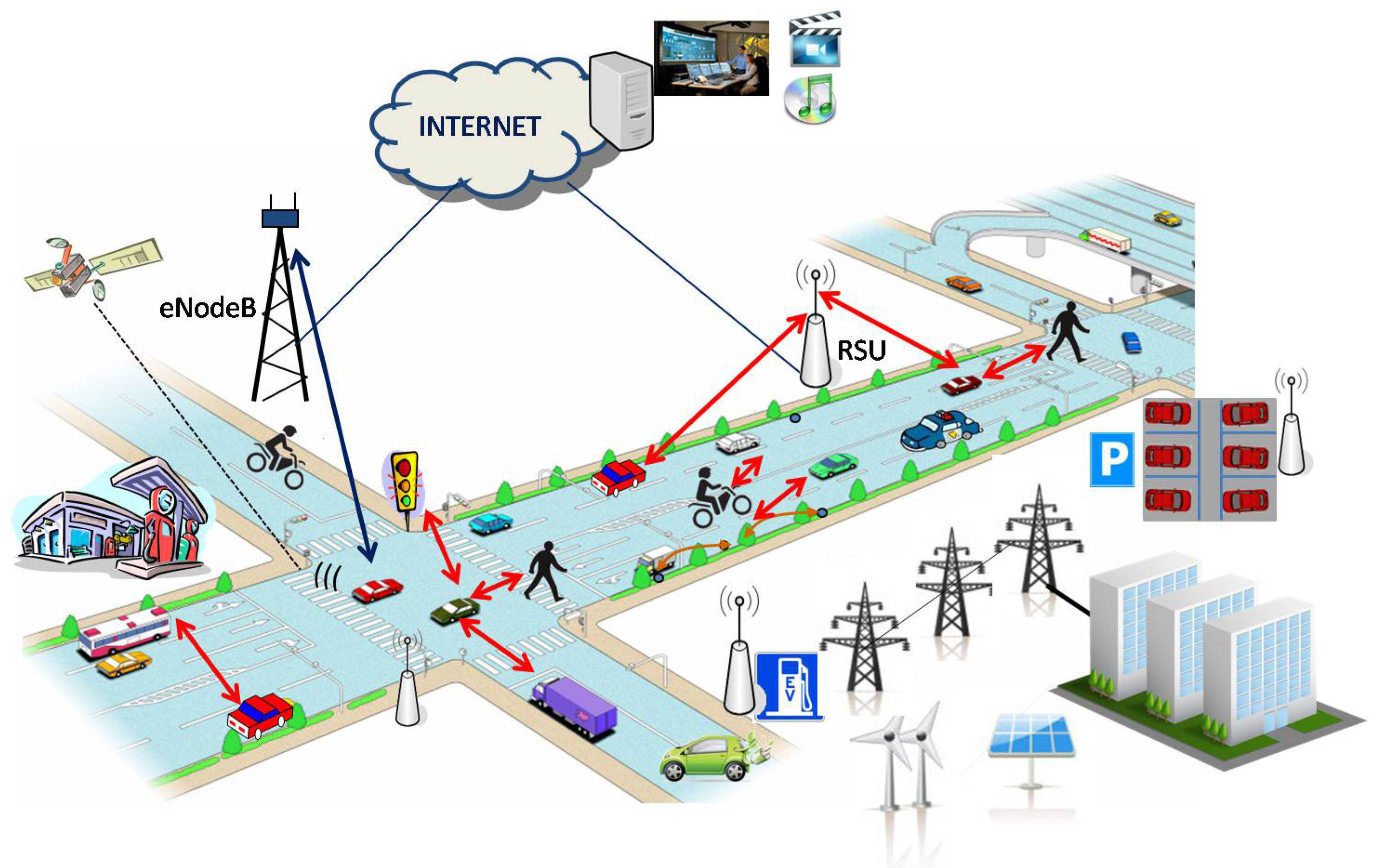
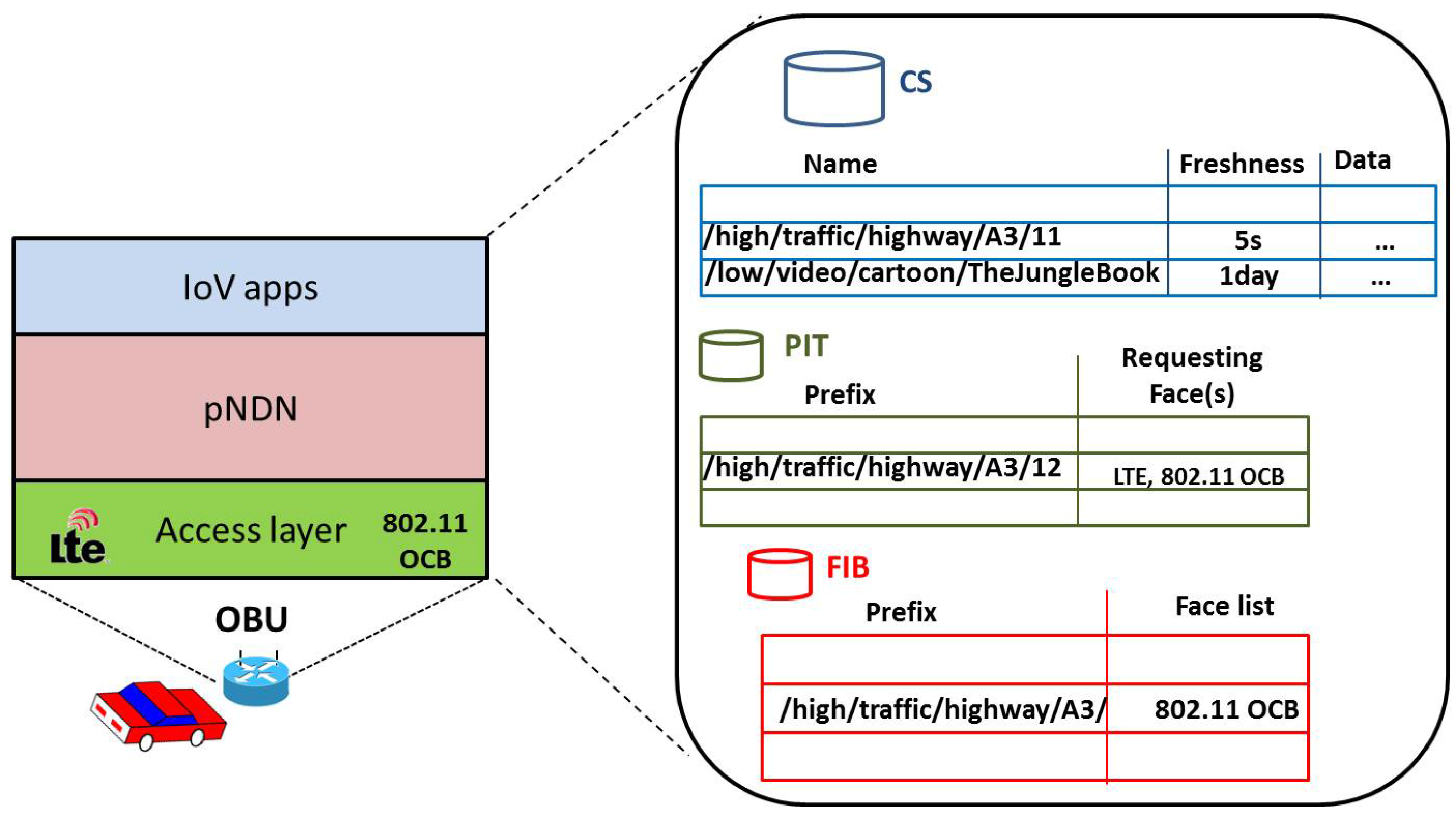
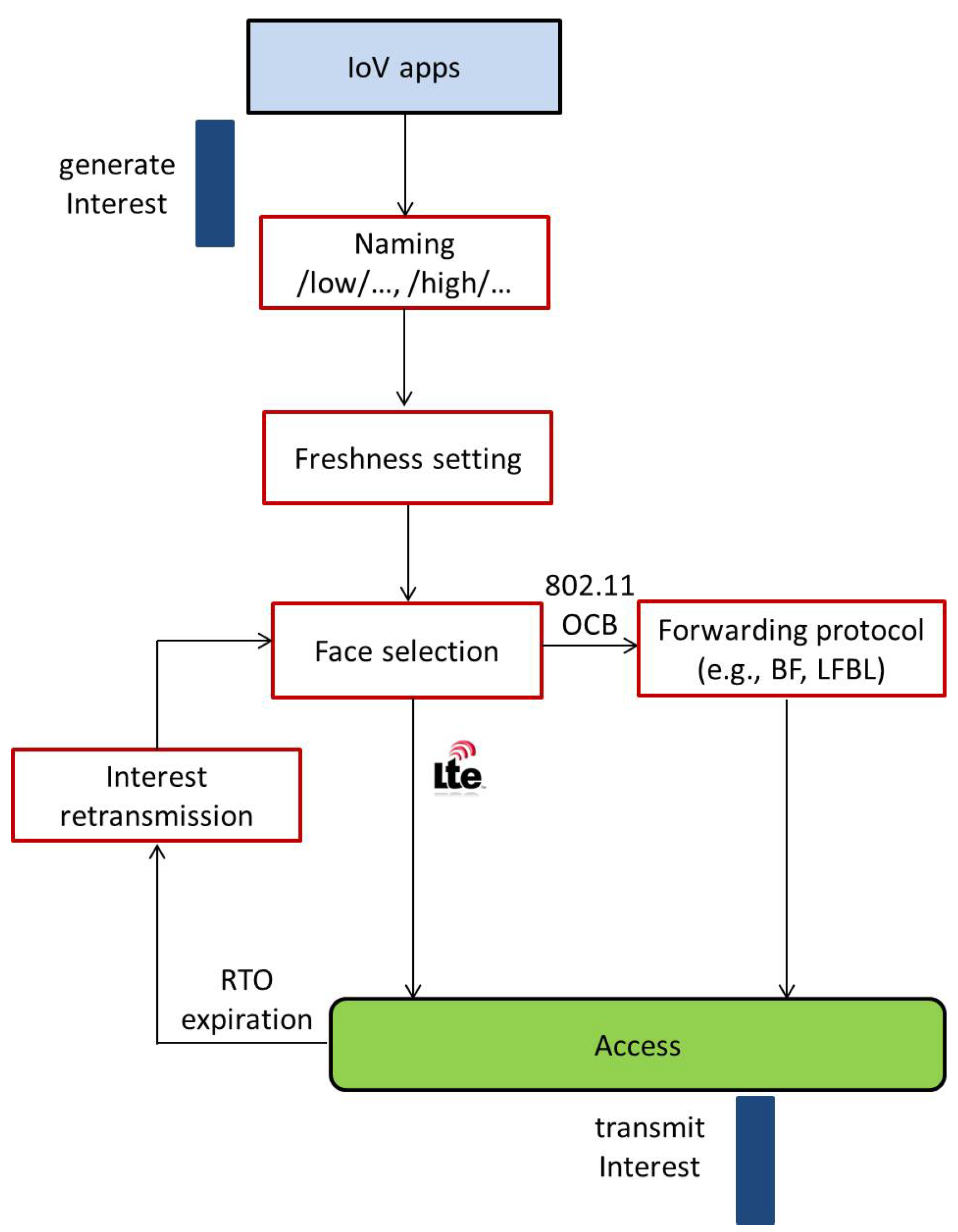


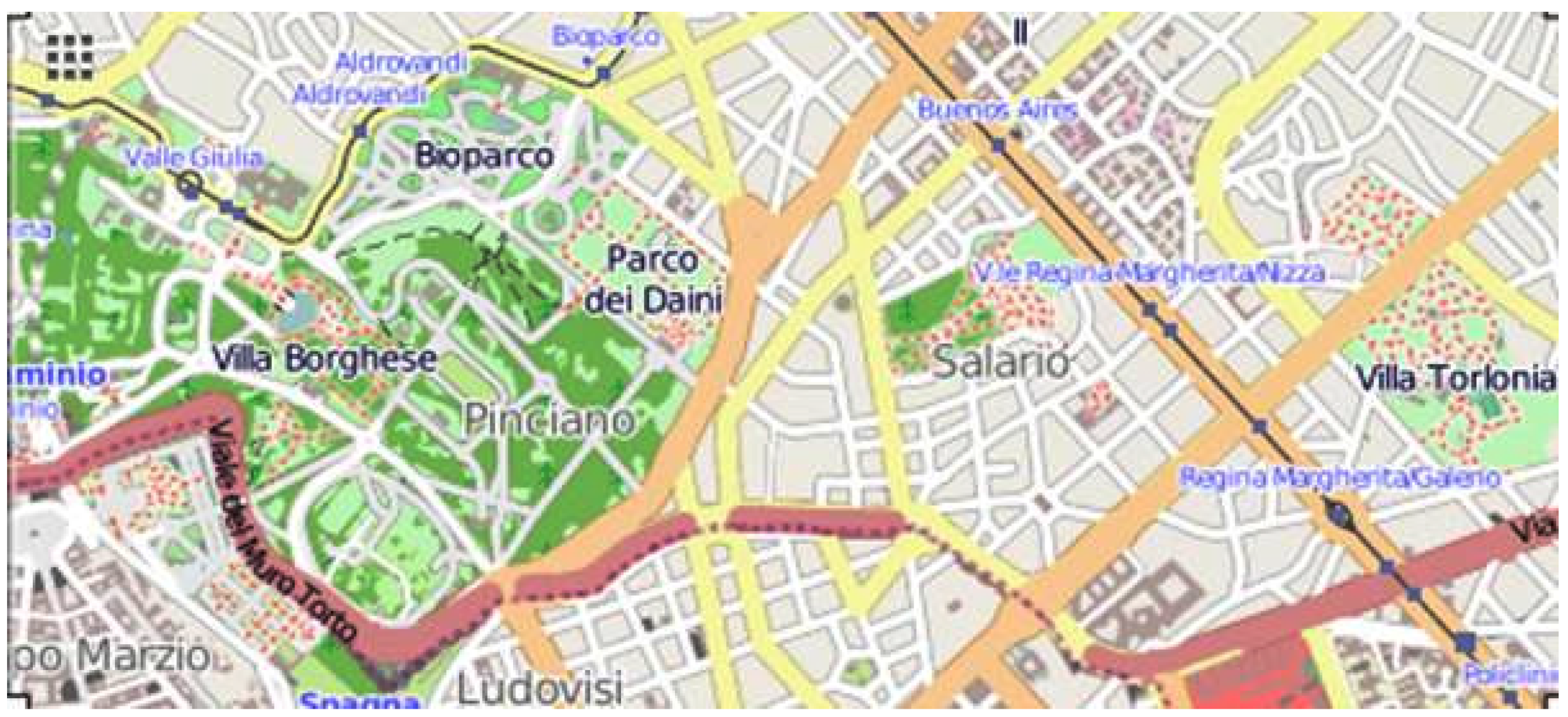
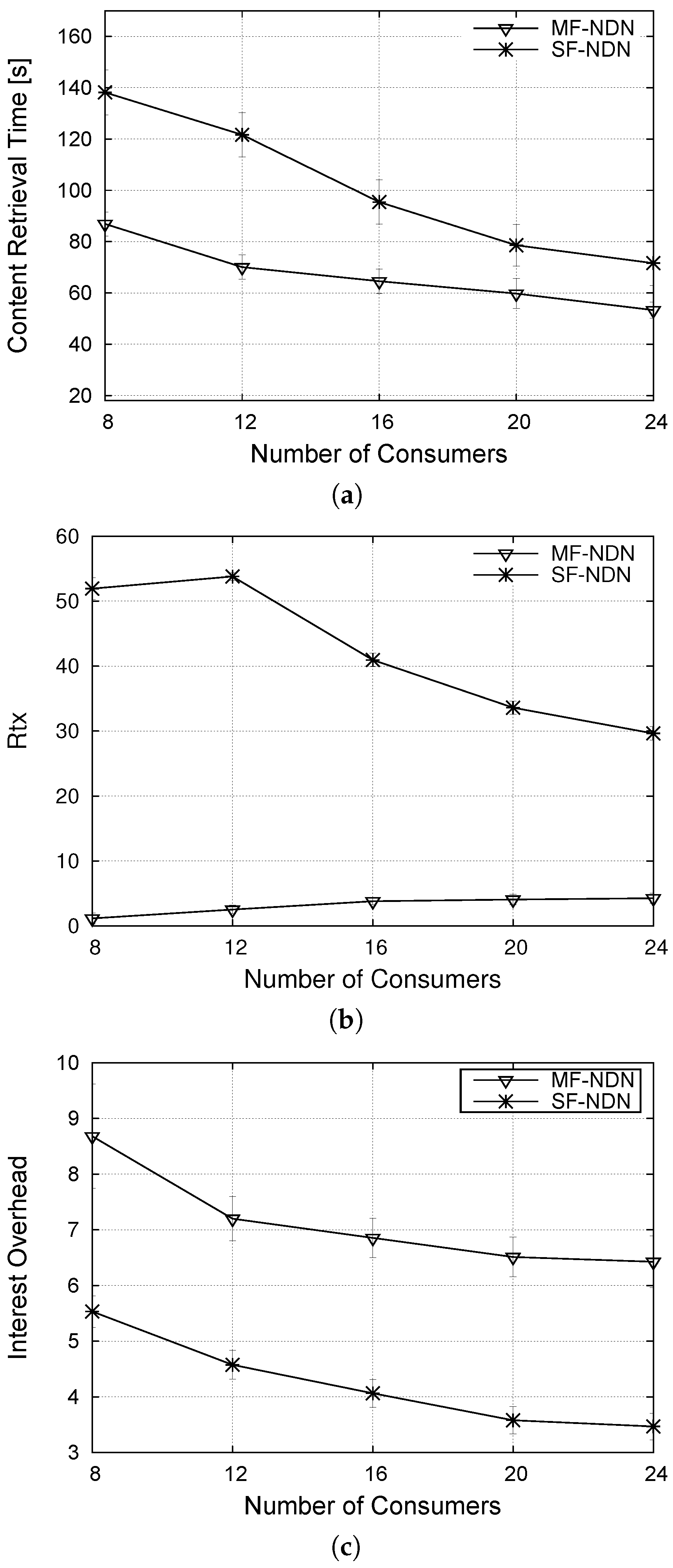
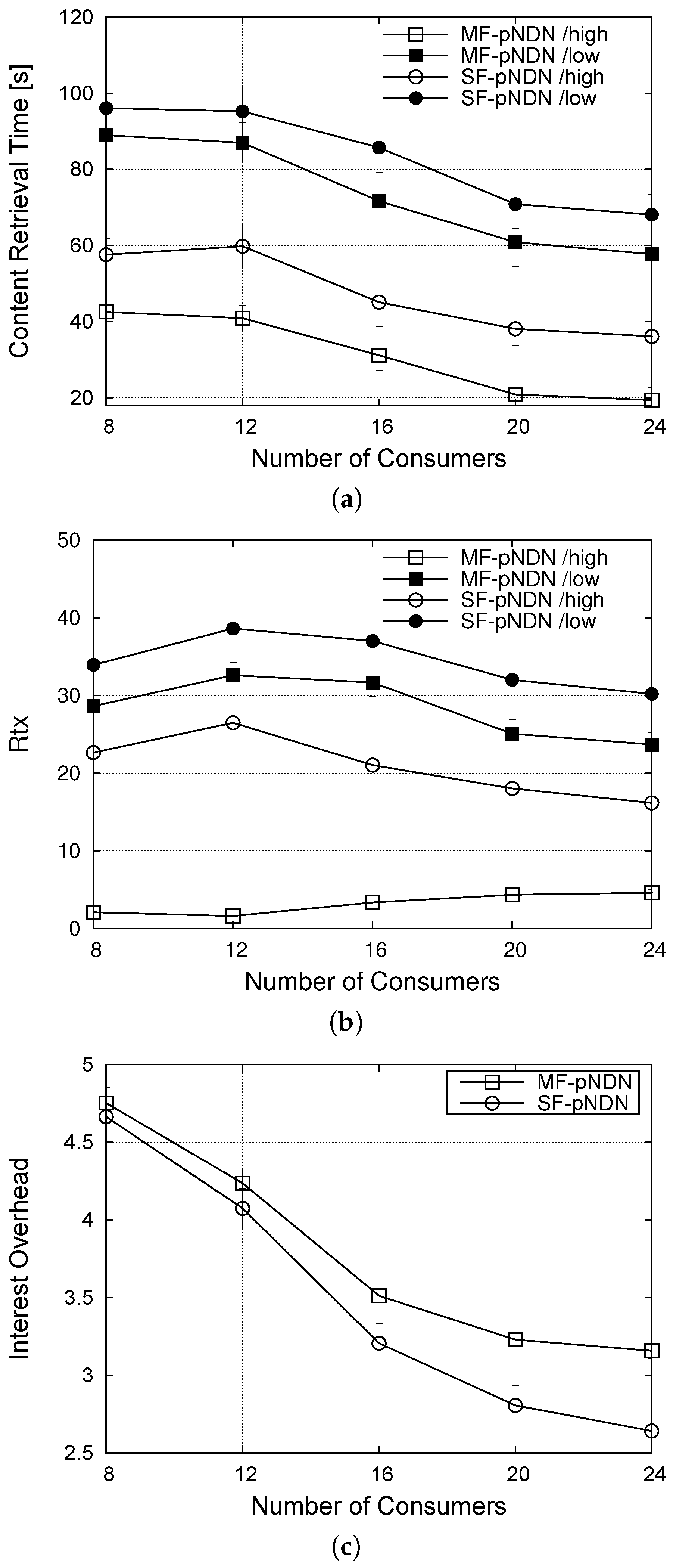
| Parameter | Value | |
|---|---|---|
| Application | Content size | 1 MB |
| Data payload | 1000 bytes | |
| Content popularity | Zipf distribution | |
| Topology | Area size | 3.2 × 1.7 km2 |
| Number of vehicles | 200 | |
| Number of RSUs | 55 | |
| Mobility model | SUMO [36] | |
| Load | Number of consumers | 8–24 |
| 802.11 OCB | Propagation model | Nakagami [37] |
| Data rate | 6 Mbps [38] | |
| 3G/LTE | RTT | 150 ms |
| NDN | Defer Window [27] | 511 |
| DeferSlotTime [27] | 58 μs |
| Number of Consumers | 8 | 12 | 16 | 20 | 24 |
|---|---|---|---|---|---|
| MF-NDN | 43.4 | 49.87 | 54.97 | 60.68 | 64.56 |
| MF-pNDN | 72.74 | 76.53 | 79.67 | 82.09 | 87.57 |
© 2016 by the authors; licensee MDPI, Basel, Switzerland. This article is an open access article distributed under the terms and conditions of the Creative Commons Attribution (CC-BY) license (http://creativecommons.org/licenses/by/4.0/).
Share and Cite
Amadeo, M.; Campolo, C.; Molinaro, A. Priority-Based Content Delivery in the Internet of Vehicles through Named Data Networking. J. Sens. Actuator Netw. 2016, 5, 17. https://doi.org/10.3390/jsan5040017
Amadeo M, Campolo C, Molinaro A. Priority-Based Content Delivery in the Internet of Vehicles through Named Data Networking. Journal of Sensor and Actuator Networks. 2016; 5(4):17. https://doi.org/10.3390/jsan5040017
Chicago/Turabian StyleAmadeo, Marica, Claudia Campolo, and Antonella Molinaro. 2016. "Priority-Based Content Delivery in the Internet of Vehicles through Named Data Networking" Journal of Sensor and Actuator Networks 5, no. 4: 17. https://doi.org/10.3390/jsan5040017






